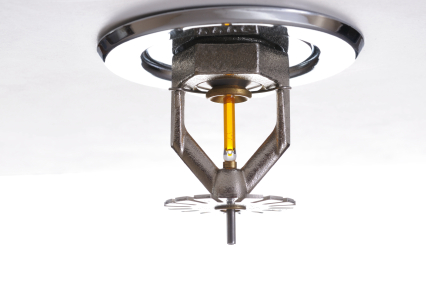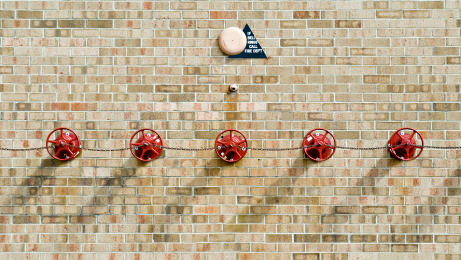 |
 |
|
|
|
Fire Protection Design in California |
|
Some sample guidelines for designing of Fire
Sprinkler systems are:
•
Integrate fire protection system with range
hoods.
•
All Fire Department connections shall face the
street and be free of any obstructions.
•
Hydraulic calculations for fire flow shall be
provided by a California licensed professional
fire protection engineer.
•
If a fire sprinkler pump is required, provide
provisions for pump housing, tank and electrical
requirements. |
|
 |
|
•
On fire mains, provide a reduced pressure
principle backflow assembly upstream of the
fire department connection.
•
All valves controlling the water supply to
automatic sprinkler systems and water flow
switches for automatic sprinkler systems shall
be electrically supervised.
•
Fire
sprinkler systems shall be designed and
installed so that they are readily serviceable.
•
Every
building shall have a fire sprinkler control
valve located 5’-0” above the floor.
•
Every riser
assembly shall have a check valve.
•
In
multi-story buildings, every floor shall have a
separate shut-off valve, check valve, tamper
switch, and flow switch at an accessible
location, with an Inspector’s test valve at the
opposite end of the building.
Exception: If each floor has an independent
shut-off valve located at the fire sprinkler
riser assembly, then a main building shut-off
valve is not required.
•
Post
indicator valves are not required to be provided
along with backflow prevention assemblies on
fire mains.
•
Fire mains
are required to have sectional controlling
valves at appropriate points per latest edition
of NFPA.
•
Provide
visual indicators of open or close valves by
using Outside Stem and Yoke (OS & Y) valves.
•
Post
indicator valves (PIV) are required, outside the
building, where a fire sprinkler main passes
through the building foundation.
•
Fire
sprinkler main drain valve discharge line shall
be piped into a sump pit or to a storm drain.
Main drain lines shall never discharge into a
sanitary plumbing fixture, not even into a floor
sink nor a floor drain.
•
The Fire
Department Connection (FDC) shall be located
upstream of the fire sprinkler riser assembly.
•
A shut-off
valve on a fire main backflow prevention
assembly shall not be considered the building’s
main shut-off valve. Each building shall have
its own separate shut-off valve as part of the
riser assembly. |
|
•
If a fire
pump is required. Provide calculations on
drawings and specifications.
•
Standpipe
systems shall be provided in buildings and areas
per latest edition of CFC and installed in
accordance with the latest edition of NFPA 14.
•
Class I wet
Manual standpipes without hoses and without hose
cabinets shall be installed in buildings where
the floor level of the highest story is located
more than 30 feet above the lowest level of fire
department vehicle access.
•
Class I wet
automatic standpipes without hose and without
hose cabinets shall be installed in buildings
where the floor of an occupied story is greater
than 75 feet above the lowest level of fire
department vehicle access.
•
Standpipe
hose connections shall be unobstructed and
readily accessible to the Fire Department, and
all connections shall conform to Code and fire
authority’s requirements.
•
All stand
pipe hose valve connections shall be in recessed
cabinets wherever possible. |
|
 |
|
|
•
CLASSIFICATION OF OCCUPANCIES:
The principal occupancy
classifications are light
hazard, ordinary hazard, and
extra hazard. The hazards
classification will be
determined based on the
occupancy classification and
permitting agency reviews.
Listed below are the
classifications with examples of
common occupancies listed under
each. The basic hazard
classification of occupancy does
not define the fire hazard
present in all areas of that
occupancy. If more hazardous
processes or areas exist within
a given occupancy, protect these
areas in accordance with the
fire protection requirements
pertaining to the hazard
classification of that area.
Determine the classification for
unlisted occupancies from the
definitions or by comparison
with one of the listed
occupancies.
1)
Light Hazard Occupancies:
Occupancies or portions of
occupancies where the quantity
and combustibility of the
contents are low and fires with
relatively low rates of heat
release are expected. Small,
scattered amounts of flammable
liquids in closed containers are
allowable in quantities not
exceeding 5 gal per fire area.
This classification includes but
is not limited to the following
occupancies:
 Churches and chapels Churches and chapels
 Gymnasiums Gymnasiums
 Clinics (dental, outpatient, patient areas
only) Clinics (dental, outpatient, patient areas
only)
 Hospitals Hospitals
 Data processing areas Data processing areas
 Mess areas Mess areas
 Dispensaries (patient areas only) Dispensaries (patient areas only)
 Drill halls (not used for storage or
exhibition) Drill halls (not used for storage or
exhibition)
 Offices Offices
 Child development centers Child development centers
2)
Ordinary Hazard Group 1
Occupancies:
Occupancies or portions of
occupancies where combustibility
is low, quantity of combustibles
is moderate, stockpiles of
combustibles do not exceed 8
ft., and fires with moderate
rates of heat release are
expected. Modest, scattered
amounts of flammable liquid, in
closed containers are allowable
in quantities not to exceed 20
gal per fire area.
This
classification includes but is
not limited to the following
occupancies:
 Sheet metal shops Sheet metal shops
 Bowling alleys
Bowling alleys
 Ship fitting shops
Ship fitting shops
 Clubs (officer, enlisted personnel, etc.)
Clubs (officer, enlisted personnel, etc.)
 Kitchens and bakery
Kitchens and bakery
 Small stores
Small stores
 Theaters and auditoriums
Theaters and auditoriums
 Welding shops
Welding shops
 Forge shops
Forge shops
 Laundries
Laundries
 Automobile parking garage
Automobile parking garage
 Electronics assembly and repair
Electronics assembly and repair
|
|
|
|
|
|
|
|
|
|
Professional Engineering
Design Services |
More
Professional Services
|
|
|
|
|





